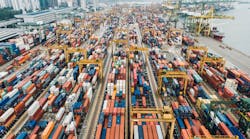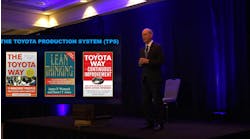Collaboration Is Key to a Sustainable Supply Chain
For now at least, the Environmental Protection Agency (EPA) or Securities and Exchange Commission (SEC) will not levy fines against U.S. manufacturing companies that fail to reduce greenhouse gas emissions (GHG) to levels in line with the Paris Climate Accord and the Biden Administration’s aggressive goals. But manufacturers across all industries find themselves under increasing pressure from state governments, investors and consumers to use the Paris Treaty and the U.S.’s pledge to fight climate change as guideposts for reducing GHG emissions—or face real and significant financial consequences.
The State of Massachusetts in March passed a law that sets specific greenhouse gas (GHG) emissions limits statewide and empowers the Department of Environmental Protection (DEP) to set so-called “emissions sub-limits” for a number of sectors including industrial processes.
(For now, Massachusetts will not penalize violators.) And in California, the “Climate Corporate Accountability Act” legislation currently under consideration would order large corporations to submit extensive reduction goals to state regulators. Those regulators would have the authority to issue fines to those that don’t meet their targets.
Meanwhile, investors and consumers are increasingly paying attention to sustainability and climate change. Research shows that 95% of consumers believe their actions impact climate change, and that includes their decision-making to the products they buy and brands they support. That extends beyond categories of products to brand vs. brand decisions and eventually SKU vs. SKU decisions.
At the same time, financial markets are rewarding companies who demonstrate their commitment to environmental, social and governance (ESG) initiatives. The Harvard Business Review reports that the demand for ESG investment options is so high that many asset management firms are rushing to pull together new offerings. In January, Blackrock Inc. CEO Larry Fink sent a letter to companies’ chief executives asking them to commit to emitting no more carbon dioxide than they remove from the atmosphere by 2050 (in line with the Paris accord).
“Better sustainability disclosures are in companies’ as well as investors’ own interests,” wrote Mr. Fink. “I urge companies to move quickly to issue them rather than waiting for regulators to impose them.”
Where to Begin?
An effective sustainability improvement plan begins with the supply chain. According to McKinsey & Company’s research, 90% of natural capital impact and 80% of greenhouse gas emissions are produced in the supply chain. Among consumer goods companies, 75-80% of emissions they produce in their supply chains come from emissions beyond their direct control.
There are a number of steps manufacturers can take this year to reduce supply chain CO2 emissions, such as transitioning away from fossil fuels to renewable energy sources, reducing product and packaging materials waste, and adopting smart water management practices.
It’s also important to trace the sourcing, movement and transfer of all materials and goods in the supply chain. The goal is to create a ‘map’ that provides a comprehensive understanding of all emissions and their environmental impact that all nodes of the supply chain produce.
Collect and Analyze Data
Data on Scope 1 and Scope 2 emissions—those under the manufacturer’s direct control—as well as Scope 3 emissions from assets such as upstream suppliers not under its control can be hidden in the ever-growing volumes of raw data produced by primary suppliers, environmental advocacy organizations, government agencies and even real-time satellite imagery. Developing the capability to collect and analyze this data enables a manufacturer to:
1. Baseline its emissions and sustainability footprint, with the measurement of business travel, office space footprints, transportation and shipping footprints, materials utilization and what’s in the materials or components it sources directly.
2. Audit all suppliers and their suppliers to gain full visibility over the entire supply chain. The end goal is to enable Tier 1 suppliers to audit and manage their suppliers directly, relieving manufacturers of that responsibility.
3. Evaluate all product roadmaps to identify which are future-proofed and which are not.
Consider Partnerships
Both Stanley Black and Decker and Ecolab—a manufacturer and provider of water, hygiene and infections solutions—are investing in startup and early-stage companies developing promising supply chain sustainability solutions. These solutions leverage automation, artificial intelligence (AI), machine learning (ML) and big data analysis technologies to improve the accuracy and speed of data collection, analysis and reporting.
For example, Stanley established the Stanley + Techstars Accelerator to mentor startups focused on incorporating artificial intelligence (AI) into solutions for advanced manufacturing and additive manufacturing processes, and sustainable packaging development. Ecolab is a founding partner of the Techstars Farm to Fork Accelerator, which supports companies developing solutions to reduce waste in global food supply chains.
Take Action; Measure Results
Achieving full visibility over the entire supply chain informs next steps—the specific policies, best practices and technologies a company can implement to reduce its environmental impact, and help its supply chain partners and consumers to do the same. These may include tapping into renewable energy sources, embracing a “right to repair” product design methodology to extend product lifespans, replacing PVC-based packaging with materials like cardboard that are easier to recycle and much less emissions-intensive, and adopting smart water management practices.
“Technology has advanced to a point where we can now monitor, evaluate and analyze facility water use in ways that we couldn’t in the past, making it easier to identify risks,” said John Guttery, Ecolab’s senior vice president of enterprise initiatives. “We have a level of transparency that allows facility managers to identify and diagnose areas of their operations that can be made more efficient through better methods of water treatment or simply avoiding using more water resources than necessary. The insights we have today provide the data needed to make the business case for action, implement effective localized solutions and report progress back to the board room.”
A Group Effort
Guttery and Dan Fitzgerald, product sustainability director at Stanley, also recommend tapping into a network of like-minded companies large and small across different industries that are committed to improving sustainability. Guttery says Ecolab seeks suppliers “who can offer alternative solutions that provide equivalent or better functionality with a lower impact.” When that’s not possible, “we additionally request that suppliers work on improving their operational footprint so the materials or components we have purchased, and will continue to purchase, have a lower carbon footprint.”
“Advances in technology are going to drive either of those scenarios,” Fitzgerald added. “The most complex problems cannot be solved within one company’s four walls. Collaboration is necessary to solve the world’s largest problems.”
Ecolab aligned its 2030 Impact Goals with the UN Business Ambition for 1.5°C, and collaboration with supply chain partners will be a key part of achieving its commitments.
“The old adage applies here,” Guttery adds. “If you want to go faster, go alone, if you want to go further, go together.”
Cody Simms is senior vice president of Climate and Sustainability, Techstars




